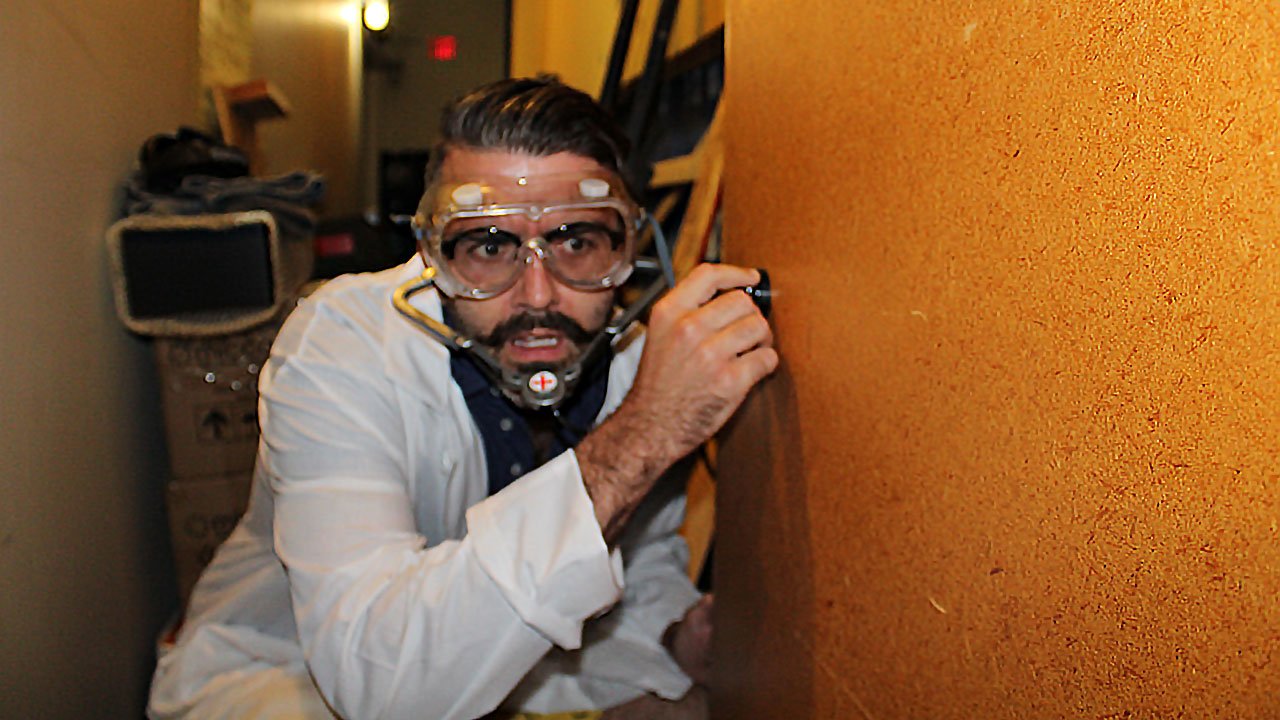Sound Spotlight: The Legendary EMT-140 Plate Reverb Effect

Welcome to the second installment of the Sound Spotlight Series. Today we are featuring the EMT-140 Plate Reverb Unit, aka “the first plate reverb”1. We’ll talk about the history of the unit, and give you some fun facts. Plus, we’ll talk about how you can incorporate the warm reverb sounds of this legendary unit into your own sounds with modern plugins.
Several years ago, an intriguing image on Avid Blogs caught my eye. It featured iZotope’s former Product Manager Brett Bunding with a stethoscope up to an original EMT-140 Plate Reverb Unit. The article, called Treat Your Voice to AAX Power with iZotope’s Nectar 2 by Alex Westner, an audio technologist, was published March 17, 2014, and no longer on Avid Blogs. I did manage to save the photo below.
What is this giant EMT-140 Plate Reverb Unit and why is he using a stethoscope?

The History: The EMT-140 Plate Reverb Effect
What is Plate Reverb? To put it simply, a metal plate, suspended by springs, sits in inside a case. When sound is pushed through that plate reverb, it vibrates. A transducer microphone on the edge of the case picks up those sounds. Originally, there was only one mic in the EMT 140, but they added a second which gave a stereo signal.
The iconic EMT-140 was groundbreaking technology and historically important for audio recording. It was the first plate reverberation unit, designed in 1957 by Wilhelm Franz, founder of Elektro-Mess-Technik (EMT)2. In some circles, it’s referred to as “The King of the Mechanical Reverb”3. It was the first to bring both smooth and dense reverb to recordings,
In the video below, recording engineer Dan Dietrich shows an original EMT-140 Plate Reverb and demonstrates how it works. This thing is mammoth – about 600 lbs!

Want a closer look at the original unit?
You can view the EMT-140 Reverberation Unit Manual from April 1971, hosted by PreservationSound.com.
The manual talks about how it was constructed and how it works. Also, it shows the remote control features and schematics.
The video below features an original EMT-140 unit. Listen to the creepy sounds coming from it.
What does EMT-140 Sound Like?
Below is a Vintage Audio Workshop video with an EMT 140 Plate Reverb Audio Test, so you can get more of an idea of what it sounds like.
Alex Westner, in the original Avid article, mentioned that the EMT 140 was used on old records by Elvis and The Beatles, but also most famously in Pink Floyd’s Dark Side of the Moon. Indeed, it gives a gorgeous sound of a huge room, but in a small space. It’s still used often by recording engineers but usually in a software format. Listen to the plate reverb on the examples below.
Recreating the EMT-140 Plate Reverb with Plugins
If you’re recording audio and want some beautiful reverb on your vocals, but don’t have room for a mattress-sized piece of equipment, you can now recreate the same vintage reverb effect on just about any DAW.
Waves Abbey Road Reverb Plates
State-of-the-art modeling of the four legendary EMT 140 reverb plates housed at Abbey Road Studios
A precise modeling of four legendary Abbey Road reverb plates (EMT 140), each with its unique character. It features a drive control to set the THD characteristics of the in/out amplifiers and the plate sheet itself. Besides, it comes with the ability to control the amount of analog noise and hum. There are four original bass cut positions with crosstalk between the stereo inputs to get a stereo leak effect.
Soundtoys Little Plate
The lush sound of plate reverb – with a modern twist.
Inspired by the original EMT 140 plate reverb, we captured the gorgeous sound and vibe of this studio classic and turned it into a fun and musically inspiring plug-in. And we couldn’t resist pushing the limits of reality, so we added a couple of fun twists that let you take Little Plate to spaces the original hardware only dreamed of.
IK Multimedia Sunset Sound Studio Reverb
Experience one of the world’s most iconic studios in your DAW
T-RackS Sunset Sound Studio Reverb lets you step inside Sunset Sound studios, capturing the sonic mojo of each one of these echo chambers, live rooms, booths, plates and springs, as well as the unique vibe of their custom consoles and classic mic collection.
In addition to the rooms and chambers, T-RackS Sunset Sound Studio Reverb also offers two of Sunset’s vintage plate reverbs, an EMT 140 and Echoplate, as well as their AKG BX-20E spring reverb. IK chose the best-sounding of Sunset’s units, adding that classic, vintage hardware reverb sound and giving you a comprehensive set of reverb types in a single plug-in.
iZotope Nectar Advanced
Vocals, in the mix
The Nectar 3 Reverb module is modeled after the classic EMT 140ST Stereo Plate Reverb with added controls for adjusting Pre-delay and Width not included in the EMT 140ST hardware unit. Combining retro feel with modern technology, the Reverb module captures the distinctive warmth and density of the EMT 140 while providing unique controls that were physically impossible in the original device.
References
- The History of EMT and Plate Reverb, WikiAudio, 10 April 2019
- Elektromesstechnik, Wikipedia.
- MT 140 TS Plate: King Of The Mechanical Reverbs, by Chris Ruggiero, Preservation Sound, 7 September 2013.
Posted by Michele








